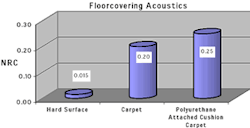A Step in the Right Direction: Polyurethane Attached Cushion Carpet
Achieving the optimum productivity improvement requires a comprehensive approach, specific to a facility and organization. As with all complex issues, a good starting point is to learn as much as possible, working toward a position of knowledge. One source of uncontrolled noise in the workplace comes from walking traffic, or "footfalls". The distraction level has worsened as workstations and walkways have become closer in proximity. High-density open-office plans may have traffic lanes weaving in and around the placement of desks and computer stations, increasing the potential that those on foot disturb those at their desk. Polyurethane attached cushion carpet serves not only as an effective noise reducer by minimizing the sound of foot traffic, but also provides effective sound absorption of airborne sound and reduces sound transmission to rooms below.Studies reported by the Carpet & Rug Institute (CRI), The Dow Chemical Company, and others clearly show the acoustic benefits of the carpet-cushion composite as compared to hard-surface floors or carpet alone. For example, consider the Noise Reduction Coefficient (NRC) measurements of products evaluated in an acoustics study conducted by Dow. The Noise Reduction Coefficient (NRC) is a standard metric describing the overall sound-absorbing characteristic of a material. R. Kring Herbert, FASA, an expert in architectural acoustics with Ostergaard Acoustical Associates notes, "A material with a NRC of 0.25, for example, absorbs about one fourth of the sound that hits its surface." As shown in the Floorcovering Acoustics Graph, the polyurethane attached cushion carpet was found to provide a 25% improvement in NRC over the same style of carpet without cushion (.25 vs. .20), a finding consistent with results in other studies.
"Depending on the specific carpet construction it can be an effective sound absorber at high frequencies and make a space sound less bright", according to Herbert. The ASID study includes a subtler observation, noting that the soft floor covering "contributes more than the measurable noise reduction values, creating an aesthetic ambiance conducive to lowered voices, heightened privacy, and reduced distraction." It is advisable to seek expert advice to understand acoustic characteristics for specific products that may vary from the results presented here.Through studies such as that conducted by ASID, polyurethane attached cushion carpet has been recognized for outstanding acoustic and ergonomic characteristics. Properly designed and implemented, a comprehensive noise control program can have a positive impact on productivity by eliminating time-consuming distractions.

